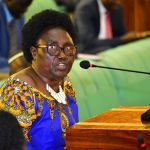The Auditor General’s report for the period ending June 2023 exposes a deepening crisis in Uganda’s Universal Primary Education (UPE) system in a damning revelation. The shortages of essential infrastructure—classrooms, desks, pit-latrines, and teachers’ houses—have reached alarming levels, jeopardizing the quality of education and hindering the achievement of programme objectives.
The report unveils a grim scenario in UPE schools, particularly in Kyeyitabya Village’s St Joseph Primary School, Kiboga District. Classrooms, already heavily congested, force up to 77 pupils to share a single space, while four pupils are squeezed onto a single desk. Shockingly, the shortage of pit-latrines has escalated to the point where up to 67 pupils are compelled to use one facility, surpassing recommended ratios.
The dire situation affects the very essence of education delivery, hindering programme objectives, pupil performance, and the overall quality of education. The report emphasizes that inadequate infrastructure compromises a safe and secure learning environment, affecting pupil attentiveness and overall school attendance.
The Auditor General issues a stark warning: unless swift action is taken to address these challenges, the hard-won gains in enhancing education access, particularly among girls and underprivileged children since the introduction of UPE in 1997, may be lost.
The blame game begins, with Mr. Joseph Ssewungu, Kalungu West lawmaker and Shadow minister for education and sports, attributing the crisis to the government’s failure to allocate sufficient resources to the education sector. He questions how schools, receiving limited funds, can be expected to provide essential amenities such as desks, classrooms, and latrines.
Dennis Mugimba, the Ministry of Education and Sports spokesperson, counters, stating that available resources cannot match the growing demand for free education, citing a 3.3 to 3.4 percent annual population growth rate.
Latrine, Classroom Deficits
The Auditor General’s report exposes alarming deficits in vital facilities. Latrine shortages breach recommended ratios, with an average of 67 pupils per latrine, far exceeding the 1:40 standard. Worse, male and female pupils are forced to share latrines in some schools, highlighting the government’s alleged neglect of sanitation responsibilities.
Classroom shortages persist, pushing the classroom-to-pupil ratio to 1:77, significantly surpassing the recommended 1:53 average. Lawmaker James Kubeketerya points to skewed budgeting, asserting that primary education has suffered due to the government’s focus on secondary education.
Contrary to official claims of infrastructure rehabilitation, Mr. Ssewungu contends that most UPE facilities have not been upgraded since 1997. Mr. Mugimba dismisses these assertions, citing a substantial budget allocation of Shs163b in the last two years for school rehabilitation.
Other Stumbling Blocks: Desks, Staff Houses, and Policy Ambiguities
The report uncovers a concerning desk shortage, with a deteriorating ratio of one desk to four pupils in FY2022/2023. Additionally, over 40 percent of audited schools lack staff houses, and where present, 50 percent are constructed with external funds.
Policy inconsistencies plague UPE, as the report highlights the government’s failure to formulate policies and guidelines to support program implementation. Abolished policies like PTA charges and automatic grade promotion lead to confusion and inconsistencies in school practices.
Multiple Curricula: Confusion Breeds Inequality
The use of different curricula further exacerbates the crisis, with 40 percent of schools employing an abridged curriculum, 46 percent using the old curriculum, and 12 percent blending both. This confusion hampers effective teaching, resulting in inconsistent learning outcomes and difficulties in pupil transitions.
The confusion extends to teacher preparation, with over 40 percent lacking schemes of work, leading to disorganized teaching and poor learning experiences.
Preparation and Hope for Change
The report recommends a comprehensive assessment of infrastructure shortages and collaboration with development partners to bridge gaps. However, skepticism lingers, with Mr. Ssewungu suggesting that private entities govern the education sector, a claim Mr. Mugimba vehemently denies.
Amidst the gloom, legislator Kubeketerya expresses hope for change in FY2024/2025 as the government allocates more resources to primary education. The question remains: Will these promises translate into tangible improvements?
Special Needs Education: A Bleak Picture
Special Needs Education (SNE) schools face an even graver situation, with learners sharing classrooms due to lack of structures. Staff shortages lead to disrupted learning experiences, with SNE pupils often receiving only life skills education.




















